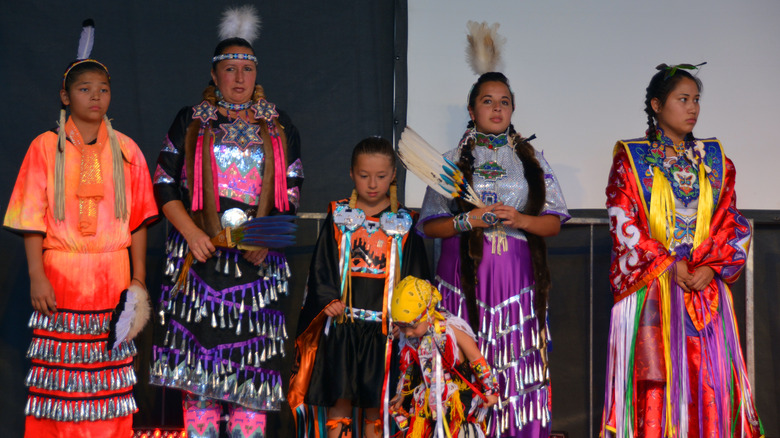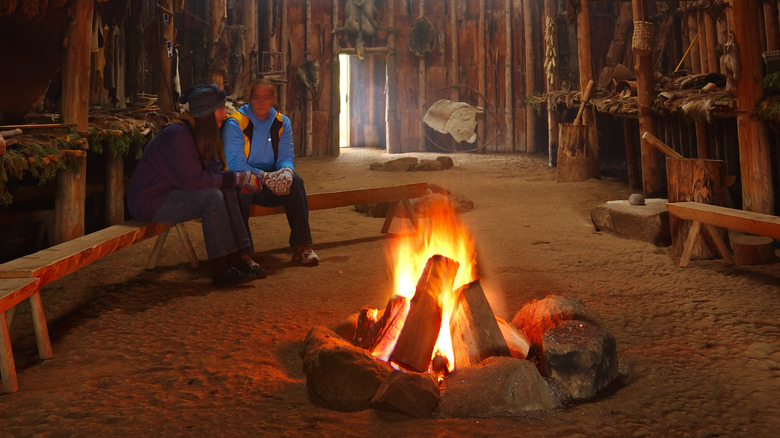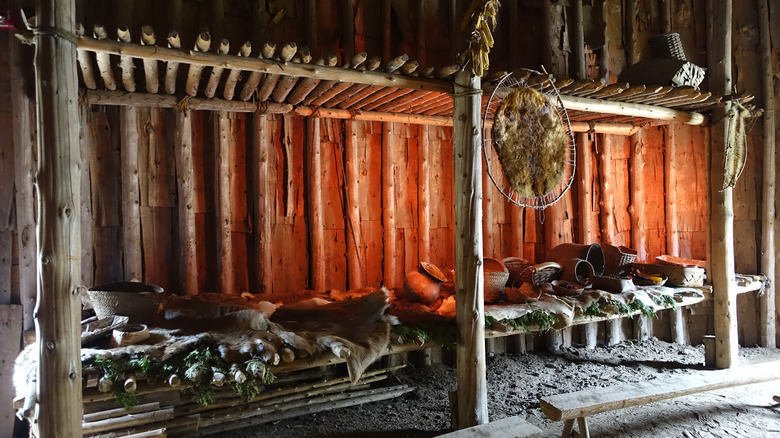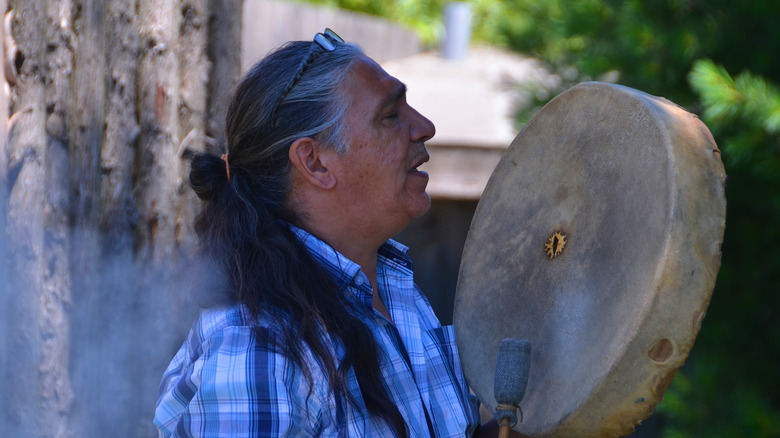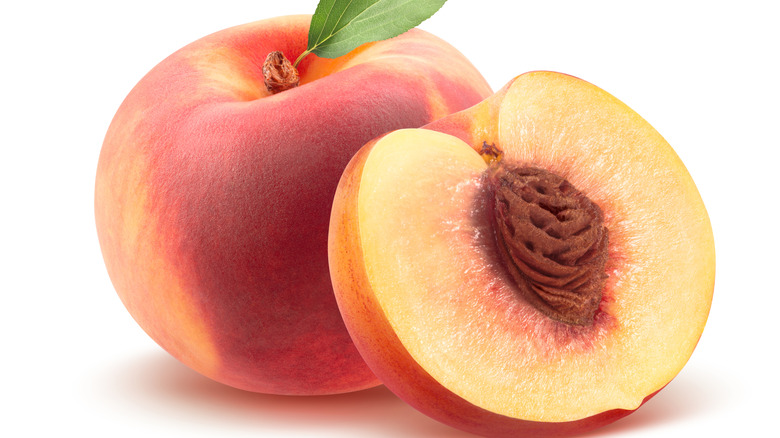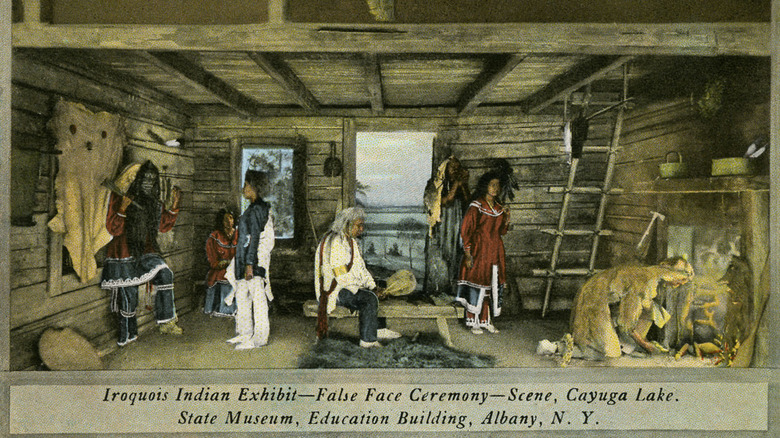The Untold Truth Of The Iroquois Midwinter Festival
The Iroquois Confederacy, or Haudenosaunee ("people who build a house") is an alliance made up of six nations: the Mohawk or Kanyen'kehà:ka , the Oneida or Onyota'a:ka , the Onondaga or Onundagaono, the Cayuga or Guyohkohnyo, the Seneca or Onöndowa'ga, and the Tuscarora or Skaruhreh. According to the Canadian Encyclopedia, the original five nations originated in the northern part of what is today the state of New York. The founding date of the Confederacy varies widely, but in 1997, two researchers proposed a date of August 31, 1142, after studying oral traditions, archeology, and astronomical calculations. The Tuscarora moved north from North Carolina and Virginia to join the Confederacy in 1722.
Per the Smithsonian National Museum of the American Indian, the Confederacy was founded on the Great Law of Peace, which asserts a basic respect for the rights of all people. The Great Law of Peace directly inspired the United States Constitution; Benjamin Franklin was particularly interested in it and how it brought together several nations into one united whole. The Founding Fathers adopted a symbol of thirteen arrows bound together to represent the thirteen original colonies bound together as one; in 1987, the United States Senate formally recognized the influence of the Great Law of Peace on the United States Constitution.
Stirring Of The Ashes
The nations of the Iroquois Confederacy have many ceremonies throughout the year that are held according to the seasons and the lunar calendar. Per the Oneida Nation website, the Midwinter ceremony begins five days after the new year moon in January and is a time to renew responsibilities for the coming year. Doug George-Kanentiio of the Mohawk Nation at Akwasasne wrote in the Utica Phoenix that Midwinter is "the annual ritual of thanksgiving, renewal, and repentance" and depending on the nation, it can last anywhere from seven days to three weeks.
As reported by Soaring Eagle American Indian Dancers, each of the tribes that makes up the Iroquois Nation celebrates the Midwinter festival a little differently, but a usual beginning to the ceremony is the "stirring of the ashes." This ritual gives thanks for the blessings of the previous year. The Oneida Cultural Heritage Department notes that this is performed on the second day of the ceremony, with the ashes symbolizing Mother Earth, turned over with wooden paddles symbolizing the earth replenishing.
Gathering within the longhouse
Both Soaring Eagle American Indian Dancers and the Oneida Cultural Heritage Department describe traditional dances that are performed early on during the Midwinter Festival. Oneida describes the Three Great Feather Dances, the first of which honors the heads of the tribes, including chiefs, clanmothers, and faithkeepers, the second of which honors all other members of the nation, and the third of which honors the Creator. Soaring Eagles notes that the Bear Dance, which is done to ask for healing from medical problems and illnesses, and the Feather Dance, which is a cheerful dance welcoming a new year, are both performed during Midwinter Festival.
Doug George-Kanentiio reports via the Utica Phoenix that people gather in traditional longhouses (the partial interior of one is shown above) for the festival, which begins with the lighting of a fire and a Thanksgiving prayer from a chief or faithkeeper holding a string of wampum. There is also a naming ceremony for newborns, who receive their clan names; the ceremony also serves to "welcome adults back to their original ways."
Tobacco, drums, and a symbolic white basket
The Oneida Cultural Heritage Department describes the third day as beginning with a Tobacco Burning Thanksgiving Ceremony, during which tobacco is collected from the celebrants and burned as a symbol of acknowledgment, thanksgiving, and renewal. This is followed by the singing of men's songs, with people's "real names" sung for the Creator and faithkeepers "put up," and the Water Drum Dance, during which everyone dances and a speaker "gives thanks to all things on earth." The article notes the important symbolism of the drum; its roundness represents the connection between all things on earth, and the beating of the drum and the circular movement of the people dancing represents the ongoing cycle of life. People gathered also drink traditional fruit juice; the Oneida Cultural Heritage Department reports that participants mix and drink blackberry juice with water medicinally while the Utica Phoenix describes "special strawberry juice, said to sustain the spirit as well as the body."
Another traditional Midwinter Festival ritual is the White Dog Sacrifice. Now performed using a white basket to symbolize a white dog, at one time the nations would sacrifice one of their beloved pets, per the Free Dictionary, decorating the animal with beads, ribbons, and wampum and burning the carcass to send prayers and gratitude along with the smoke to the Creator.
The Peach Stone Game
The Peach Stone Game is another traditional ritual performed during the Iroquois Midwinter Festival. Per Soaring Eagles, the game represents a similar one played between the Creator and his evil brother during the earth's creation; it symbolizes the good luck given to people by the Creator and is thought to predict the outcomes of next year's crops.
Participants use six peach stones that have been burned and blackened on one side and shake them in a bowl, playing an ongoing game of chance similar to rolling dice or flipping coins. Beans are used to mark the winners and the games can go on for days. Different clans often play one another; men and women can also compete against each other. The Oneida website reports that it's traditional to bet on the Peach Stone Game using wampum, traditional clothing, lacrosse sticks, and turtle rattles as collateral while avoiding anything red, which denotes anger, black, which denotes death, or shiny, which denotes greed.
The Medicine Societies and their sacred masks
The Oneida website notes that toward the end of the Midwinter Festival, the False Face Medicine Society and the Cornhusk Masks Medicine Society remind members to take the opportunity to renew themselves. The Second Face Museum of Cultural Masks reports that most Iroquois nations had three medicine societies and that both the False Face and Husk Face dancers can cure illness by blowing ash or sprinkling water on patients. The Husk Masks represent earthbound spirits from the opposite side of the world who taught the Iroquois how to hunt and fish. People wearing the masks perform the Fish Dance and the Women's Dance and men and women often wear masks depicting the opposite sex.
Per Britannica, False Face masks must be carved from the trunk of a living tree, with the tree ritually addressed before carving with both tree and mask-fed tobacco leaves before the mask is separated. The masks are thought to contain great power, able to heal the sick if treated respectfully and causing harm if treated disrespectfully. In 1995, the Grand Council of the Haudenosaunee released a policy statement declaring every False Face mask sacred, prohibiting the sale, exhibition, or pictorial depictions of the masks, writing "the non-Indian public does not have the right to examine, interpret, or present the beliefs, functions, and duties of the secret medicine societies of the Haudenosaunee."
